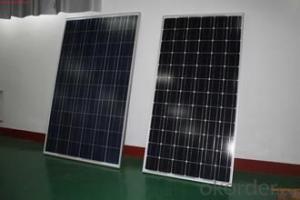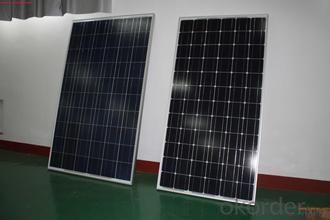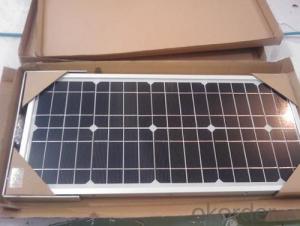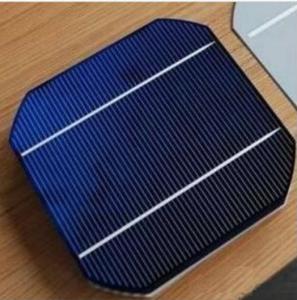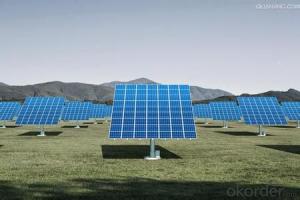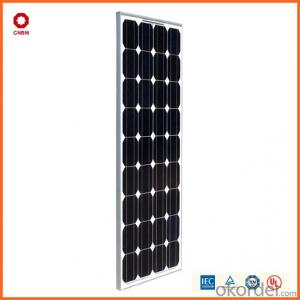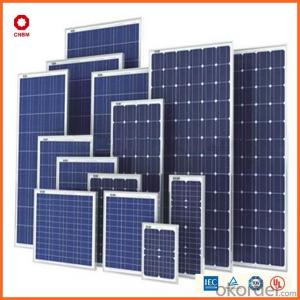Polymer Based Monocrystalline Silicon Solar Cell with CE,TUV,MCS,CEC,ROHS
- Loading Port:
- China Main Port
- Payment Terms:
- TT OR LC
- Min Order Qty:
- -
- Supply Capability:
- -
OKorder Service Pledge
Quality Product, Order Online Tracking, Timely Delivery
OKorder Financial Service
Credit Rating, Credit Services, Credit Purchasing
You Might Also Like
Quick Details
| Model Number: | |||||
| Material: | Size: | Number of Cells: | |||
| Max. Power: | Certificates: | Power Tolerance: | |||
| Frame Material: |
Packaging & Delivery
| Packaging Detail: | Inner box: 161x108x6cm 1pc/inner box Carton box: 163x110x32cm 5pcs/carton box 20FT: 240pcs 40FT: 485pcs |
| Delivery Detail: | 10days after confirm the order |
Specifications
1.Excellent in quality and reasonable in price
2.CE,TUV,MCS,CEC,RoHS
3. high efficiency
4.OEM & ODM
5.25year life time
220W monocrystalline silicon solar cell with CE,TUV,MCS,CEC,RoHS
Scification:
| Maximum Power | 220Wp |
| Power Tolerance | 1%~3% |
| Optimum operating voltage(Vmp) | 47.4V |
| Optimum operating current(Imp) | 4.64A |
| Open ciruit voltage(Voc) | 58.6V |
| Short circuit current(Isc) | 5.07A |
| Maximum system voltage | 1000V DC |
| Voltage temperature coefficient | -155±10mV/°C |
| Current temperature coefficient | +0.06±0.01%/°C |
| Power temperature coefficient | -0.5±0.05%/°C |
| Cell type | Monocrystalline solar cell |
| Dimension | 1596*1065*46mm |
| Weight | 21.5Kg |
| STC | 1000W/m2,AM 1.5,25ºC |
| Frame Material | Clear anodized aluminium frame |
| Operating temperature | -40°C~+85°C |
| Storage temperature | from-40°C~+85°C |
| Voltage standoff | AC200V DC3000V |
| Maximum wind resistance | 60m/s |
| Surface maximum load capacity | 200Kg/m2 |
| Maximum hail load capacity | 25mm,80km/h |
| Efficiency of cell | 16.5~17% |
| Warranty | 5 year warranty for products,25 years for 80% power |
- Q: How does the efficiency of solar cells vary with different materials?
- The efficiency of solar cells varies with different materials due to their unique properties and ability to absorb and convert sunlight into electricity. Certain materials, such as monocrystalline silicon, have high efficiency rates due to their ability to efficiently convert a larger portion of sunlight into electricity. On the other hand, materials like amorphous silicon or thin-film solar cells have lower efficiency rates but offer other advantages such as flexibility and cost-effectiveness. Overall, the efficiency of solar cells is heavily influenced by the materials used and their specific characteristics.
- Q: How do solar cells impact the local economy?
- Solar cells have a positive impact on the local economy by creating new job opportunities in the solar industry, attracting investments, and reducing energy costs for businesses and households. Additionally, the installation and maintenance of solar panels contribute to local economic growth and stimulate the development of a sustainable and resilient energy infrastructure.
- Q: Can solar cells be used for powering communication systems?
- Yes, solar cells can be used to power communication systems. Solar cells convert sunlight into electrical energy, which can then be used to power various electronic devices, including communication systems. This renewable source of energy is a sustainable and environmentally friendly option for powering communication systems, especially in remote or off-grid locations where access to traditional power sources may be limited.
- Q: Can solar cells be used to power large industrial facilities?
- Yes, solar cells can be used to power large industrial facilities. However, the feasibility and effectiveness of using solar cells for such facilities depend on factors such as the size of the facility, its energy requirements, available space for installing solar panels, and the cost-effectiveness of implementing and maintaining the solar power system.
- Q: How much electricity can a solar cell generate?
- The amount of electricity a solar cell can generate depends on various factors such as the size and efficiency of the cell, the intensity and duration of sunlight, and the environmental conditions. On average, a standard solar cell can generate around 1 to 2 watts of electricity per square meter under optimal conditions.
- Q: Are solar cells affected by shade?
- Yes, solar cells are affected by shade. When solar cells are partially shaded, it reduces their efficiency and overall power output. Shading can create hotspots on the shaded cells, causing them to generate less electricity and potentially damage the cells. Therefore, it is important to ensure that solar panels are installed in areas with minimal shade to maximize their performance.
- Q: Can solar cells be used in airports?
- Yes, solar cells can be used in airports. They can be installed on rooftops, canopies, or other open spaces in airports to generate clean and renewable energy for various purposes such as lighting, power supply, and charging stations. Additionally, solar cells can contribute to reducing the carbon footprint and overall energy costs of airports.
- Q: Can solar cells be used to power outdoor signage?
- Yes, solar cells can be used to power outdoor signage. Solar cells are designed to convert sunlight into electricity, making them an ideal choice for outdoor applications where access to traditional power sources may be limited. By harnessing solar energy, outdoor signage can operate efficiently and sustainably without relying on the electrical grid.
- Q: Can solar cells be used to power homes?
- Yes, solar cells can be used to power homes. Solar photovoltaic (PV) systems convert sunlight into electricity, which can then be used to power various appliances and lighting in households. These systems typically consist of solar panels installed on rooftops or other sunny areas, along with inverters and batteries to store excess energy for use during non-sunny periods or at night. With advances in technology and decreasing costs, solar power has become an increasingly viable and sustainable option for homeowners to generate their own electricity.
- Q: Can solar cells be used on wearable technology?
- Yes, solar cells can be used on wearable technology. Advances in technology have made it possible to integrate solar cells into small and flexible materials, making them suitable for use in wearable devices. These solar cells can generate and store energy from sunlight, allowing wearable technology to become self-sustaining and reducing the need for frequent recharging or battery replacements.
Send your message to us
Polymer Based Monocrystalline Silicon Solar Cell with CE,TUV,MCS,CEC,ROHS
- Loading Port:
- China Main Port
- Payment Terms:
- TT OR LC
- Min Order Qty:
- -
- Supply Capability:
- -
OKorder Service Pledge
Quality Product, Order Online Tracking, Timely Delivery
OKorder Financial Service
Credit Rating, Credit Services, Credit Purchasing
Similar products
Hot products
Hot Searches
Related keywords
